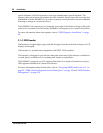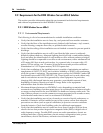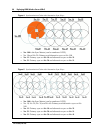
32 Deploying KIRK Wireless Server 600v3
14117800, Ed.2.6
3.1 Recommendations for KWS600v3/KIRK Repeater Placement
• In large halls, the KWS600v3/repeater (wall) should be installed vertically in the
middle of the space below the drop ceiling.
• In corridors, the KWS600v3/repeater (wall) should be installed vertically preferably
at corridor intersections where propagation patterns follow the corridor patterns. The
KWS600v3/repeater should point towards the corridor and preferably in the middle
height between the floor and the actual ceiling. In case there are high objects in the
area, the KWS600v3/repeater (wall) should be installed above those objects but still
kept distant from the ceiling.
• The repeater (ceiling) should be installed in the middle of corridors and small rooms.
• In multi-story buildings, KWS600v3 and or repeaters may be installed on opposite
sides of the floors to take advantage of the floor-to-floor coverage. The coverage
design cannot rely entirely on floor-to-floor propagation; each case must be verified
due to variations in local attenuation patterns.
• If the building contains a central open space area with windows to the other areas,
KWS600v3 and or repeaters may be installed in this open space to provide a good
coverage for the rooms in the inner circle on all floors (e.g. hotels).
• If a KWS600v3 and or repeater (wall) hangs vertically on a wall, the RF coverage in
front of the KWS600v3 and or repeaters is twice as large as the coverage at the rear.
• KWS600v3 and or repeaters should not be installed near large metallic objects.
• Reinforced concrete structures have a high attenuation factor inside the building.
They decrease the RF coverage range of the KWS600v3 and or repeaters and therefore
requires a higher number of KWS600v3 and or repeaters in the building. Lighter
types of construction require fewer KWS600v3 since attenuation figures are
considerably lower.
3
3.2 Deployment of a KIRK Wireless Server 600v3 Multi-Cell
Note: This section only contains deployment information specific to the KWS600v3. For
more information about deployment in general, refer to
the Deployment Guide
accompanying the Deployment Kit. The Deployment Guide provides instructions on
how to use the Deployment Kit to determine the most suitable locations for the different
radio units.
3.2.1 Sync over Air
As a user moves from one KWS600v3 radio coverage area to another, the call must be
handed over to the next radio unit. To create handover between radio units it is necessary
to establish synchronization chains. For more information about synchronization chains,
refer to
“Examples of Synchronization Chains” on page 33. If the synchronization
between radio units is lost, then handover is not possible and ongoing calls will be
terminated.
Note: Each KWS600v3 must be placed within the radio coverage area of at least one other
KWS600v3 or repeater (radio units).


















